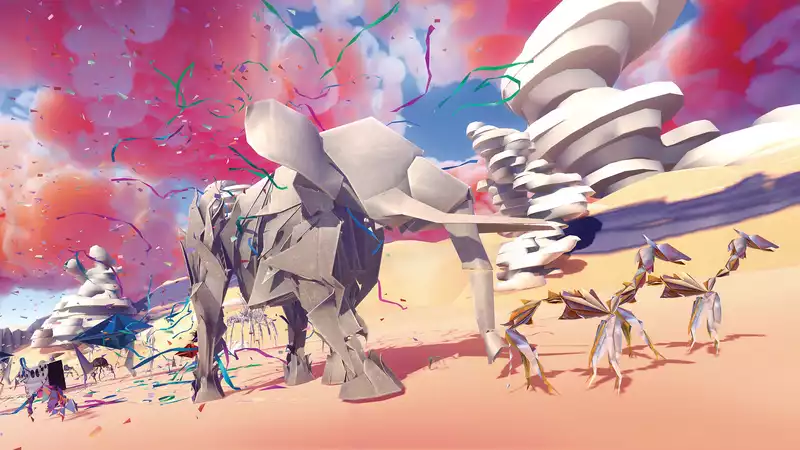Part puzzle game, part God game, and all extremely strange, Paper Beast is unlike anything I've ever played before. The exclusive VR experience puts you at the center of a unique wildlife simulation, where the animals are not flesh and fur, but origami creatures roaming the harsh desert world. It's a fascinating and surprisingly emotional experience, even if you've only seen the surface of its potential.
"Paper Beast" is divided into two parts, beginning with a story mode. While the exact nature of that story is open to interpretation, your basic role in the game is that of a capricious deity, acting variously as a savior to the animals that roam its world or as a source of chaos. The game's eight chapters are divided into several individual scenes, each consisting of small puzzles that move the game creatures from A to B
. The paperbeast beasts are marvels of VR design. The first animal we encounter is a hairy porcupine-like animal with a paper streamer flowing from its back. This hairy mass of paper sniffs and shuffles past at waist height, which is fun, like meeting a friendly dog on a nighttime walk. Later, we encounter a horse-like creature called a papybolus that loves to eat twisted pieces of paper, a strange crustacean that is as crazy as a dung beetle and rolls sand into a ball, and even a towering cardboard elephant. The various shapes and sizes of these animals give an impressive view of VR's unique scale and depth.
But the allure of these creatures is not just in their fascinating appearance. Each animal has its own set of behaviors that must be learned in order to solve the game's puzzles. For example, the papybolus (Papyvori.) To avoid predators or to guide its fragile body into a network of caves to protect it from the wind. Puzzles often combine these behaviors with the ability to manipulate the surrounding terrain. Sandballs created by the crab creature can be picked up and thrown on the ground to create sand pathways that other animals use to cross water or climb slippery slopes.
The result is a series of dynamic environmental conundrums. The solution is always set in stone, but there is no set way to manipulate both the animals and the terrain. You are constantly pushing and pulling the world around you to suit your needs. But working with AI animals has its drawbacks. You often need encouragement to move it to the right place, and Paper Beast's controls are unusually imprecise for a VR game, and the solutions are rarely perfect.
In terms of story, "Paper Beast" is as strange as "Death Stranding," but unlike Kojima's delivery sim, "Paper Beast" does not thoroughly explain everything that happens. Quite the opposite: while playing "Paper Beast," you will encounter a spectacular animal parade, float a giant radio in a glacial crevasse where sticky vines latch onto everything nearby, and ride a hot air balloon that grows out of a tree. None of this has a clear reason or context. At one point, a jet-black alphabet rains down from the sky, blackening the ground and attempting to drown the creatures made of paper beneath it. After a while it stops and moves on. It is a fascinating and at the same time strange work. [11] [12] "Paper Beast" is (ironically) reluctant to state its message explicitly, but the mood of each scene is always clear. For the most part, "Paper Beast" is a chilling experience, but its tone ranges from festive to melancholy to tragic. It is undeniably moving to watch Papibolus wrestle with the game's strong winds and be tossed into the air, inevitably folded like a sad animal kite. One particularly disturbing puzzle involves connecting the papybolus to a scuttling turtle-like creature called "Density," which can withstand the virtual gale of the game. But Dencity is a slow creature. To encourage them to speed up, they throw their hatchlings down a mountainside, and the parent turtles chase after them. Fortunately, the hatchlings don't get hurt, but that didn't stop me from feeling like a baby-eating bastard.
The story mode of "Paper Beast" is littered with memorable moments, but I always felt constrained by the physical limitations of its vignettes. It takes a long time to unfold mechanically, and it ends just as I'm about to capture it. Fortunately, "Paper Beast" includes a literal sandbox mode that allows you to turn the desert wilderness into your own virtual wildlife sanctuary. You can flood lakebeds and dried-up rivers, place plants and animals, and even create storms. Particularly eye-catching is the zoom system. When the touch controllers are pressed against each other, they become god-like in size, allowing the user to see the entire map.
The sandbox mode demonstrates the depth of Paper Beast's simulation. Plants naturally reproduce, and animals exist in a clear food chain of prey, predators, and apex predators. It is wonderful to see it in motion, but also quite pointless, like a fantastical God game prototype. [This is the biggest problem with "Paper Beasts," which feels like two parts of a game that should be one cohesive whole. The game is directed by Eric Chahi, who also directed "Another World" and "Heart of Darkness." But it is Chahi's "From Dust" that this game reminds me of most. Like "From Dust," "Paper Beast" is visually spectacular and systematically clever, but it struggles between a dynamic god game and a more formulaic puzzler. Whereas "From Dust" attempted to reconcile these two personalities within a single experience, "Paper Beast" splits them apart. Both aspects work within a limited context, but ultimately fail to materialize, feeling like the seductive flavor of a more grandiose experience.
.

Comments